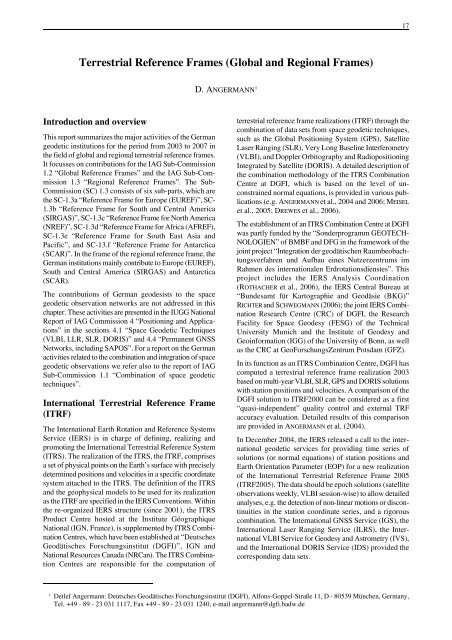NATIONAL REPORT OF THE FEDERAL REPUBLIC OF ... - IAG Office
NATIONAL REPORT OF THE FEDERAL REPUBLIC OF ... - IAG Office
NATIONAL REPORT OF THE FEDERAL REPUBLIC OF ... - IAG Office
Create successful ePaper yourself
Turn your PDF publications into a flip-book with our unique Google optimized e-Paper software.
Terrestrial Reference Frames (Global and Regional Frames)<br />
Introduction and overview<br />
This report summarizes the major activities of the German<br />
geodetic institutions for the period from 2003 to 2007 in<br />
the field of global and regional terrestrial reference frames.<br />
It focusses on contributions for the <strong>IAG</strong> Sub-Commission<br />
1.2 “Global Reference Frames” and the <strong>IAG</strong> Sub-Commission<br />
1.3 “Regional Reference Frames”. The Sub-<br />
Commission (SC) 1.3 consists of six sub-parts, which are<br />
the SC-1.3a “Reference Frame for Europe (EUREF)”, SC-<br />
1.3b “Reference Frame for South and Central America<br />
(SIRGAS)”, SC-1.3c “Reference Frame for North America<br />
(NREF)”, SC-1.3d “Reference Frame for Africa (AFREF),<br />
SC-1.3e “Reference Frame for South East Asia and<br />
Pacific”, and SC-13.f “Reference Frame for Antarctica<br />
(SCAR)”. In the frame of the regional reference frame, the<br />
German institutions mainly contribute to Europe (EUREF),<br />
South and Central America (SIRGAS) and Antarctica<br />
(SCAR).<br />
The contributions of German geodesists to the space<br />
geodetic observation networks are not addressed in this<br />
chapter. These activities are presented in the IUGG National<br />
Report of <strong>IAG</strong> Commission 4 “Positioning and Applications”<br />
in the sections 4.1 “Space Geodetic Techniques<br />
(VLBI, LLR, SLR, DORIS)” and 4.4 “Permanent GNSS<br />
Networks, including SAPOS”. For a report on the German<br />
activities related to the combination and integration of space<br />
geodetic observations we refer also to the report of <strong>IAG</strong><br />
Sub-Commission 1.1 “Combination of space geodetic<br />
techniques”.<br />
International Terrestrial Reference Frame<br />
(ITRF)<br />
The International Earth Rotation and Reference Systems<br />
Service (IERS) is in charge of defining, realizing and<br />
promoting the International Terrestrial Reference System<br />
(ITRS). The realization of the ITRS, the ITRF, comprises<br />
a set of physical points on the Earth’s surface with precisely<br />
determined positions and velocities in a specific coordinate<br />
system attached to the ITRS. The definition of the ITRS<br />
and the geophysical models to be used for its realization<br />
as the ITRF are specified in the IERS Conventions. Within<br />
the re-organized IERS structure (since 2001), the ITRS<br />
Product Centre hosted at the Institute Géographique<br />
National (IGN, France), is supplemented by ITRS Combination<br />
Centres, which have been established at “Deutsches<br />
Geodätisches Forschungsinstitut (DGFI)”, IGN and<br />
National Resources Canada (NRCan). The ITRS Combination<br />
Centres are responsible for the computation of<br />
D. ANGERMANN 1<br />
1 Detlef Angermann: Deutsches Geodätisches Forschungsinstitut (DGFI), Alfons-Goppel-Straße 11, D - 80539 München, Germany,<br />
Tel. +49 - 89 - 23 031 1117, Fax +49 - 89 - 23 031 1240, e-mail angermann@dgfi.badw.de<br />
17<br />
terrestrial reference frame realizations (ITRF) through the<br />
combination of data sets from space geodetic techniques,<br />
such as the Global Positioning System (GPS), Satellite<br />
Laser Ranging (SLR), Very Long Baseline Interferometry<br />
(VLBI), and Doppler Orbitography and Radiopositioning<br />
Integrated by Satellite (DORIS). A detailed description of<br />
the combination methodology of the ITRS Combination<br />
Centre at DGFI, which is based on the level of unconstrained<br />
normal equations, is provided in various publications<br />
(e.g. ANGERMANN et al., 2004 and 2006; MEISEL<br />
et al., 2005; DREWES et al., 2006).<br />
The establishment of an ITRS Combination Centre at DGFI<br />
was partly funded by the “Sonderprogramm GEOTECH-<br />
NOLOGIEN” of BMBF and DFG in the framework of the<br />
joint project “Integration der geodätischen Raumbeobachtungsverfahren<br />
und Aufbau eines Nutzerzentrums im<br />
Rahmen des internationalen Erdrotationsdienstes”. This<br />
project includes the IERS Analysis Coordination<br />
(ROTHACHER et al., 2006), the IERS Central Bureau at<br />
“Bundesamt für Kartographie and Geodäsie (BKG)”<br />
RICHTER and SCHWEGMANN (2006); the joint IERS Combination<br />
Research Centre (CRC) of DGFI, the Research<br />
Facility for Space Geodesy (FESG) of the Technical<br />
University Munich and the Institute of Geodesy and<br />
Geoinformation (IGG) of the University of Bonn, as well<br />
as the CRC at GeoForschungsZentrum Potsdam (GFZ).<br />
In its function as an ITRS Combination Centre, DGFI has<br />
computed a terrestrial reference frame realization 2003<br />
based on multi-year VLBI, SLR, GPS and DORIS solutions<br />
with station positions and velocities. A comparison of the<br />
DGFI solution to ITRF2000 can be considered as a first<br />
“quasi-independent” quality control and external TRF<br />
accuracy evaluation. Detailed results of this comparison<br />
are provided in ANGERMANN et al. (2004).<br />
In December 2004, the IERS released a call to the international<br />
geodetic services for providing time series of<br />
solutions (or normal equations) of station positions and<br />
Earth Orientation Parameter (EOP) for a new realization<br />
of the International Terrestrial Reference Frame 2005<br />
(ITRF2005). The data should be epoch solutions (satellite<br />
observations weekly, VLBI session-wise) to allow detailed<br />
analyses, e.g. the detection of non-linear motions or discontinuities<br />
in the station coordinate series, and a rigorous<br />
combination. The International GNSS Service (IGS), the<br />
International Laser Ranging Service (ILRS), the International<br />
VLBI Service for Geodesy and Astrometry (IVS),<br />
and the International DORIS Service (IDS) provided the<br />
corresponding data sets.











